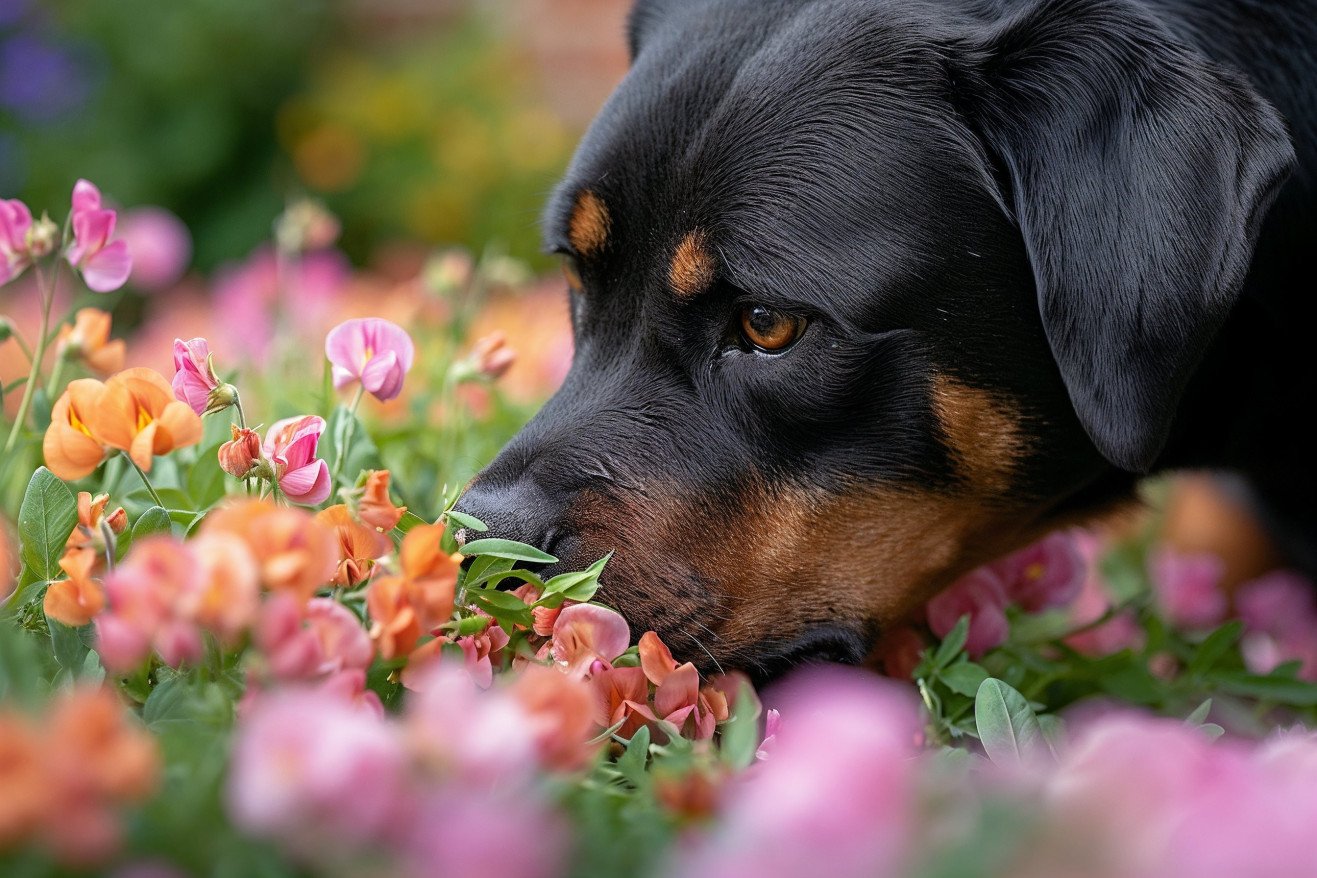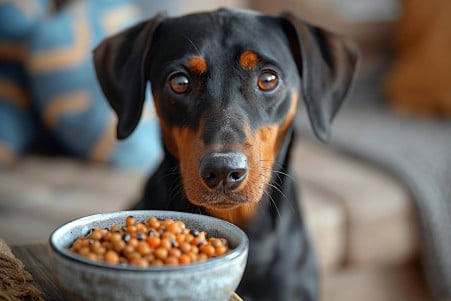Can Dogs Eat Sweet Peas? Uncovering Healthy Canine Nutrition
5 February 2024 • Updated 6 February 2024

So, can dogs eat sweet peas? In terms of canine nutrition, are sweet peas a healthy option or something to avoid? Dogs can eat peas as part of a balanced diet, and they can provide vitamins and fiber.
However, it’s important to steer clear of sweet pea plants (Lathyrus species) as they are poisonous to dogs and can lead to muscle issues and paralysis. Make sure to always introduce new foods to your dog slowly and talk to your vet.
This article will take a deep dive into the complexities of dog nutrition and the details of dogs and vegetables. We will rely on reputable veterinary sources and toxicology studies to help you understand whether or not sweet peas are safe for dogs.
Throughout our discussion of the research of animal health professionals, we will also put their findings into the larger context of a dog’s relationship with plant-based nutrition to make sure you have all the information you need to make the best decisions for your dog’s health.
Can dogs eat sweet peas?
What Your Dog Needs in Their Diet and the Role of Vegetables
All dogs need a diet that includes proteins, fats, carbohydrates, vitamins, and minerals to stay healthy. Proteins and fats are the most important sources of energy, and while dogs don’t need carbohydrates, they can provide energy and help maintain the health of the intestines. Dogs are omnivores, and as a result, they can eat a diet that includes both animal and plant-based foods, according to VCA Animal Hospitals.
Vegetables can add fiber, essential nutrients, and water to a dog’s diet. PetMD includes a list of vegetables that are safe for dogs, including broccoli, carrots, and green beans, all of which can provide vitamins and fiber.
However, it’s important to feed them in moderation. Vegetables should be used to supplement the main parts of a dog’s diet, not replace them, and no more than 10% of a dog’s daily diet should consist of treats.
It’s important to prepare vegetables properly when you’re adding them to your dog’s diet. Make sure they’re washed, unseasoned, and cut into pieces that are an appropriate size to prevent choking. And, of course, it’s important to make sure you talk to a vet before you make any changes to your dog’s diet, especially if they have any health issues.
While it’s important to understand the benefits of adding vegetables to your dog’s diet, it’s also important to understand the potential dangers of some plants.
Differentiating Between Edible Peas and Poisonous Sweet Peas
It’s important to note that sweet pea plants of the genus Lathyrus, including Lathyrus latifolius, Lathyrus odoratus, and Lathyrus sativus, are not the same as the garden-variety peas found in dog food. While sweet peas do contain vitamins, minerals, and protein, they also contain a poisonous substance called aminoproprionitrile.
Aminoproprionitrile inhibits collagen synthesis and can lead to musculoskeletal and central nervous system issues in dogs, including lathyrism, which is associated with muscle weakness and paralysis.
Symptoms of sweet pea poisoning can include lethargy, tremors, seizures, and even death, so it’s important for dog owners to take their pets to the vet immediately if they suspect they’ve eaten sweet peas.
Because of the danger sweet peas pose to dogs, it may be best to consider other vegetables for your pet. The American Kennel Club recommends green peas, which include snow peas and sugar snap peas, as a healthy option.
Not only do these peas provide hydration and essential nutrients, but they are also low in calories. By choosing these vegetables, dog owners can make sure their pets get the benefits of eating vegetables without the danger of sweet pea plants.
Plant Poisoning in Dogs
The plant kingdom is a rich and varied landscape of beauty and danger, especially for our four-legged friends. Plants such as oleander, sago palm, and certain lilies are just a few examples of the many toxic plants that can be dangerous to dogs, with toxic compounds that include cardiac glycosides and substances that can cause kidney failure.
Clinical signs of plant poisoning in dogs can include vomiting, diarrhea, arrhythmias, and even organ failure. Epidemiological data from a PubMed study by F. Caloni found that plant poisoning was responsible for 5.7% of all animal-related calls to the Milan Poison Control Centre over a 12-year period, with dogs being the most commonly affected species.
Pet parents and pet professionals can take steps to help prevent plant poisoning in dogs. These include keeping toxic plants out of a dog’s reach, supervising dogs when they are outside, and learning to identify toxic plants.
Pet parents are also important partners with veterinarians in the recognition and treatment of poisonings, as prompt veterinary care can be life-saving. Pet parents and veterinarians must work together to increase awareness and ensure that appropriate steps are taken to prevent and treat plant poisoning in dogs to help keep them safe and healthy.
Aminoproprionitrile in Dogs
Aminoproprionitrile (BAPN) is a compound found in sweet peas that can have toxic effects on dogs. It works by inhibiting the synthesis of collagen, the protein that helps maintain the strength and structure of the body’s tissues.
A study in PLOS ONE shows that BAPN inhibits the enzymatic crosslinking of collagen, a process that is important for the proper formation and repair of connective tissue. This can lead to a condition called lathyrism, which is characterized by changes in collagen morphology and can cause skeletal and joint malformations in dogs.
Dogs that have been poisoned with BAPN may show signs of toxicity, including lameness, weakness, and, in extreme cases, paralysis.
The long-term effects of BAPN poisoning can be severe and may even lead to chronic joint disease and connective tissue damage.
This study highlights the importance of understanding the specific toxins that can affect dogs and the impact they can have on their health.
How to Add New Foods to Your Dog’s Diet
When adding new foods, like fiber-rich and vitamin-packed peas, to your dog’s diet, it’s important to do so carefully. BetterVet notes that you should start with small amounts and monitor your dog’s reaction. If there are no signs of digestive upset or allergic reactions (both of which would require a call to your vet), you can gradually increase the amount.
Veterinarians are especially important in this process, especially if your dog has any pre-existing health issues. They can help you make sure that you’re making the right dietary changes to meet your pet’s nutritional needs while keeping them healthy. As PetMD points out, it’s important to remember that treats and extras should make up no more than 10% of your dog’s daily caloric intake if you want to keep their diet balanced.
Make sure to add vegetables like carrots and green beans to your dog’s meals or use them as treats, but make sure they’re washed, plain, and prepared correctly. Keep an eye on your dog’s reactions and make sure to adjust their diet based on their unique needs to keep them healthy. By doing this, you can make sure that you’re striking the right balance between nutrition and safety in your dog’s diet.
Navigating the Pea Dilemma in Dog Nutrition
In our quest to learn more about dog nutrition, the importance of vegetables, particularly peas, in a dog’s diet has become clear. While it’s safe to feed dogs some healthy vegetables, including snow peas, sugar snap peas, and garden peas, it’s important to know the difference between these and sweet peas.
The American Kennel Club warns that sweet peas, which contain the toxic compound aminoproprionitrile, can lead to musculoskeletal and central nervous system issues in dogs.
Good dog parents pay close attention to their pets’ diets and understand the fine line between providing the right nutrition and keeping them safe. It’s not enough to know what vegetables are good for dogs; it’s also important to know what vegetables can be harmful. This means working with a vet to make sure we’re meeting our pets’ individual nutritional needs while keeping them safe, as Purina points out.
In the end, we should enjoy the fun of feeding our dogs healthy treats while also being aware of the dangers. In this way, we can live up to the trust our dogs put in us to care for them with knowledge and care.


